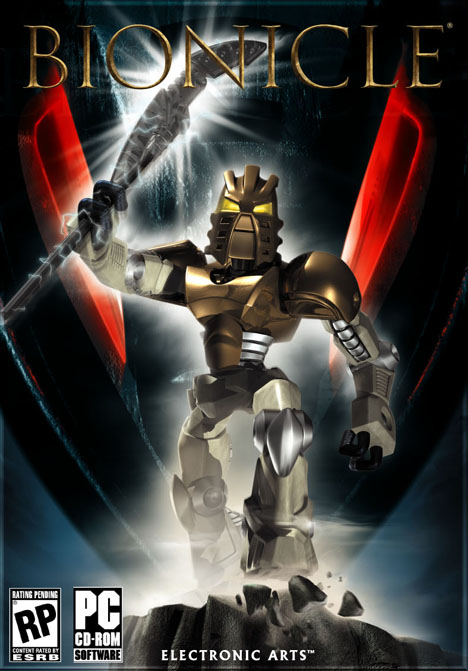
I have battled RAHI, BOHROK, BOHROK-KAL, RAHKSHI, and MAKUTA himself to bring you this review of the BIONICLE® PC CD-ROM game. As challenging as they were, there is a far greater foe lurking in this software. But let us get some other things out of the way first.
The History
Over two years ago, the original BIONICLE™: The Legend Of Mata Nui PC CD-ROM game was cancelled, principally because it was not finished on time. Unlike that doomed game, this one shipped. Also unlike that game, this one is available cross platform on the PlayStation 2, Xbox, and GameCube consoles. I have not played the console versions, and therefore I am just reviewing the PC version here.
The Name
It is just BIONICLE® . “The Game” is not to be found anywhere, sort of like “The Movie” was dropped from BIONICLE: Mask Of Light .
System Requirements
You might not be interested in a review unless you can run the program. The box lists Windows 98, ME, 2000, and XP as compatible operating systems. You will need a CPU clocked at 600 MHz or faster and 64 MB or more of RAM in your system. You’ll also need 900 MB of free disk space on your hard drive. The game comes on two CD-ROMs, but you only need the first CD after installation.
For some, the most restrictive system requirement will be the video card. You will need a video card with at least 32 MB which supports hardware transform and lighting and DirectX 9.0. The box specifically lists a requirement for either an NVIDIA GeForce 256 (or greater) or an ATI Radeon (or greater) graphics chipset, but I have played the game on an Intel graphics chipset with success at 640 x 480 resolution. At higher resolutions, the Intel-based video rotates the image 90 degrees. I have also played the game on an NVIDIA GeForce2 GTS at 1024 x 768 with no problems.
As you will be reminded by a short animated advertisement every time you start the game, BIONICLE has been enhanced for the Pentium 4 with Hyperthreading (HT). Unfortunately, I have not had the opportunity to play the game on a P4 with HT yet. The README file states that, among other things, “the enhanced water interacts with the characters, creating realtime ripples and reflections from the environment, including the sky.” I can tell you that without HT, there are no reflections and no refraction and that the water sorely needs them. The other HT enhancements include “changing skies in the outdoor levels (that) give a heightened dramatic atmosphere.” Given how little I have seen of the sky playing the game, I don’t think changing skies are going to dramatically change your impressions of the game.
The two computers I used to test the game are 1) a 2.2 GHz Celeron with Intel video at 640 x 480, and 2) a 1.5 GHz Pentium 4 with NVIDIA GeForce2 GTS video at 1024 x 768. The P4/NVIDIA computer definitely performs better than the Celeron/Intel system when running this game. Extrapolating down, I would think that a computer with just the bare minimum system requirements would render the game unplayable.
The Story
Here we come upon BIONICLE ‘s first major problem: the story. Take the entire BIONICLE saga, throw it into a blender, and then pour nine-tenths of it down the drain. What you are left with is all mixed up and missing quite a bit. That is our story.
For those uninitiated in the world of BIONICLE, this game offers little in the way of introduction to or explanation of the characters and conflict as part of the storyline. Don’t expect to win any converts to BIONICLE with this game. For knowledgeable BIONICLE fans, the story offers only contradiction and mischaracterization. An early example: It is GALI who suggests that the TOA split up, each to defend their own Wahi. Unity indeed! Near the end of the game, LEWA NUVA defeats a RAHKSHI and claims its KRANA !
The game begins with the six original TOA sitting and watching as VAKAMA and the MATORAN put on a play. TAKUA shows up and immediately starts whining about his predicament as he is being chased by RAHI and BOHROK. The TOA drive back the baddies, and the game begins.
Unlike the GBA game, this game unfolds in a strictly linear fashion. Gameplay starts with TAHU, continues with KOPAKA, and then passes to GALI NUVA. That is right, GALI NUVA . Those of you hoping to play all six TOA and then all six TOA NUVA will be disappointed. Only TAHU is playable in both his original and NUVA forms.
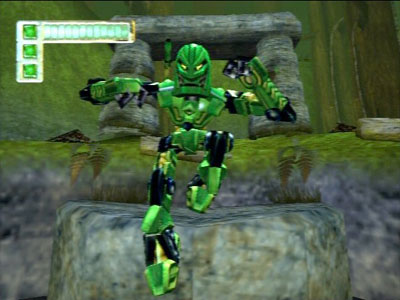
LEWA from the PS2 Preview.
You won’t see him in the PC game.
After GALI NUVA, play then continues with POHATU NUVA, ONUA NUVA, and LEWA NUVA. After that, TAHU NUVA goes lava surfing until finally TAKANUVA takes on MAKUTA. After you have completed each TOA (or TOA NUVA), you can go back to earlier TOA (or TOA NUVA) if you wish, but you can’t skip ahead .
Game Play
Most of the game is played from a third-person chase perspective, which means you will be looking at everyone’s back quite a bit.
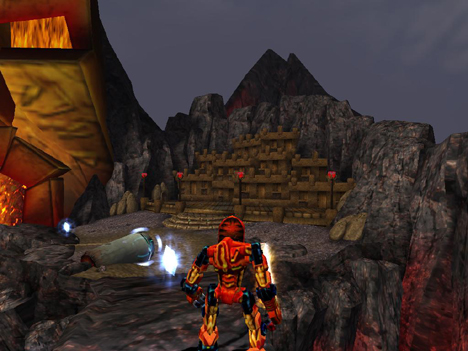
TAHU at the beginning of the game.
As always, click the picture to display the full image.
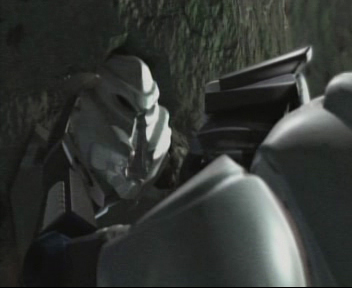
ONUA NUVA finds the KANOHI of Elemental Energy.
From E3 Preview CD-ROM.
You lose health each time you are hit by the “dark energy” blasted at you by your opponents. In addition to the KANOHI of Elemental Energy, you can restore health by collecting Amana Volo Spheres. These spheres appear when you defeat your foe. With the many sources of healing and energy available to you, if you lose in battle it is probably more your fault than it is your opponents’.
Other than the KANOHI of Elemental Energy, you won’t be finding any masks. You use your masks solely for shielding. You can absorb dark energy and convert it to elemental energy if you activate your shield at just the right time. You have one other source of elemental energy: the atmosphere around you. You will periodically receive boosts to your elemental energy just for hanging around. If you are in a hurry, you can hold down your shield and gather in elemental energy from all around you. You are vulnerable while you do this however.
The TAHU level is a jumper with some battle elements thrown in. Stay away from the lava as that means instant disassembly. In a nice touch, on many levels when a TOA/TOA NUVA is disassembled, their tools are all that are left behind. When you are disassembled, you are reassembled at an indeterminate earlier part of the game and usually have to face previously defeated enemies again and collect previously collected lightstones again.
Jump across enough lava and defeat enough RAHI and you will eventually face a BOHROK. If you defeat the BOHROK, you claim his KRANA and seek out KOPAKA in a cut scene.
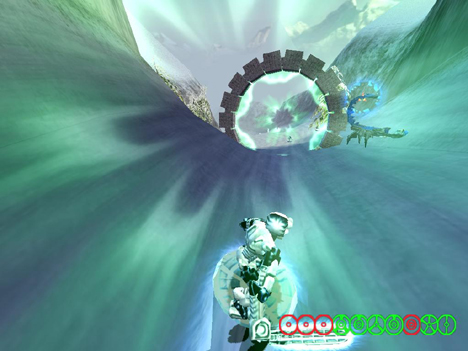
KOPAKA “skiing”.
Don’t expect much of a challenge blasting anything. Targeting is automatic. You don’t have to be facing your foe to hit it, but it does seem to help somewhat. Some levels offer a triple-blast which at least looks impressive.
This level is the shortest and divided into two parts. The second part is essentially the first part repeated. The worst thing about this level is listening to NUJU talk in the cut scene. Not only is he intelligible, with MATORO nowhere to be found, but the actor voicing NUJU affects an obviously fake stereotypical Native American accent. (If you don’t know, NUJU is supposed to have transcended normal speech, speaking in beeps, clicks, and whirs only intelligible to MATORO, his translator.)
Moving right along, GALI NUVA is next. The BOHROK have been defeated, the TOA have transformed into TOA NUVA, and the BOHROK-KAL are upon the scene. Infected RAHI still abound however.
This is the most claustrophobic GA-KORO I have ever encountered. Everywhere you look there are sky-high walls.
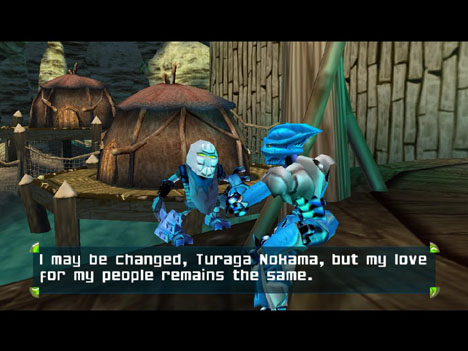
GALI talking to NOKAMA.
As one would expect, much of your time as GALI NUVA is spent swimming. But most of the real work is accomplished jumping on trampoline leaves and leaping across large gaps. A final battle with all six of the BOHROK-KAL in a draining whirlpool is either challenging or a breeze, depending on how twitchy you are.
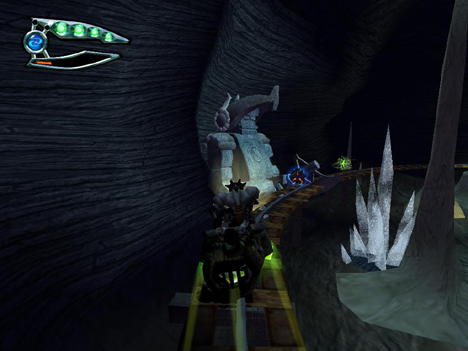
POHATU mine train.
POHATU NUVA does not spend much time in PO-WAHI. Instead, he falls down into the mines of ONU-WAHI and hitches a ride on a mine train car to inform ONUA NUVA of the RAHKSHI. A MATORAN tags along in back.
You can see the Chronicler’s Staff in the full POHATU NUVA image linked above. The green lights along the top are your health and the red bar across the bottom indicates your elemental energy reserves. Contrary to initial expectations, no actual plastic toy Chronicler’s Staff was included in the box. Only the manual, installation manual, and two discs were included.
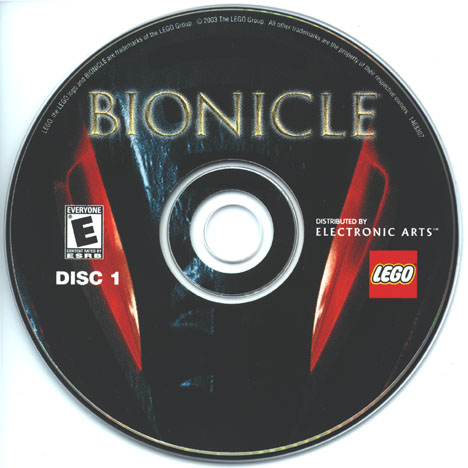
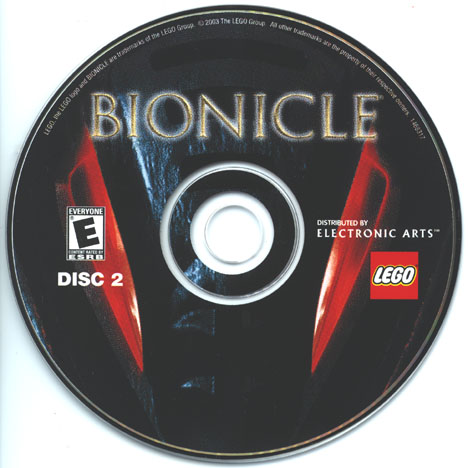
The two discs.
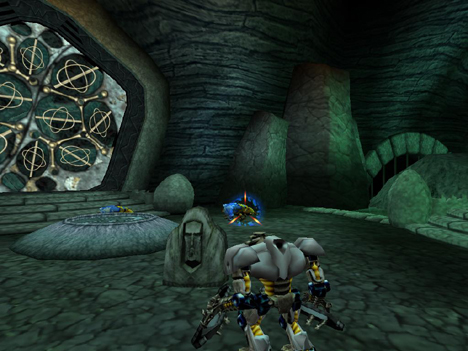
ONUA NUVA squashing bugs and moving rocks.
A final battle with the RAHKSHI LERAHK involves more rocks and more switches. A well-devised plan goes a long way in defeating LERAHK, who has voluntarily locked himself in a protective central chamber with a fatal flaw.
Meanwhile, GALI NUVA informs LEWA NUVA of the RAHKSHI threat. LEWA NUVA has problems of his own. He needs to rescue enough MATORAN to power up his Suva. To do this, LEWA surfs the branches of the trees of LE-WAHI, shooting MATORAN down from the mysterious gaseous balloons which hold them captive.
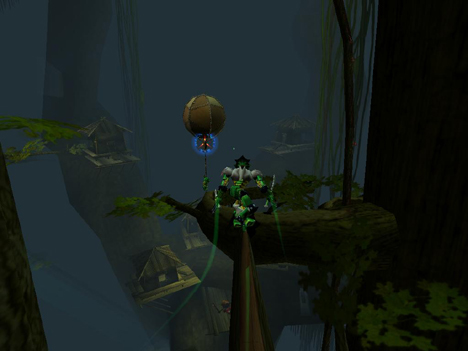
LEWA NUVA “surfing” the trees.
You can only fly so far before the wind gives out and you fall. Falling usually results in disassembly, but occasionally you may be treated to LEWA NUVA walking on water, due to a bug in the program. Because of this flying limitation, you frequently need to land on islands or trampoline leaves, or grab a rope or vine. Many of these give way almost as soon as you land on them. Toward the end of the level, you fly in the wake of a GUKKO bird to sustain yourself.
Your reward for all of this aerobic activity is a battle with the RAHKSHI PANRAHK on a bunch of log rafts lashed together. This involves a little bit of strategy as you try to isolate PANRAHK and send him into the swamp before he does the same to you. You do this by destroying the rafts out from under each other and hopping about on those that are left.
Meanwhile, TAKUA has both found the Mask of Light and lost it to the RAHKSHI KURAHK. TAKUA is speaking to TAHU NUVA about this when POHATU NUVA runs up to tell TAHU NUVA that he has to go to the bathroom. Well, not really. POHATU NUVA just dances around the whole time as if he needs to go to the bathroom.
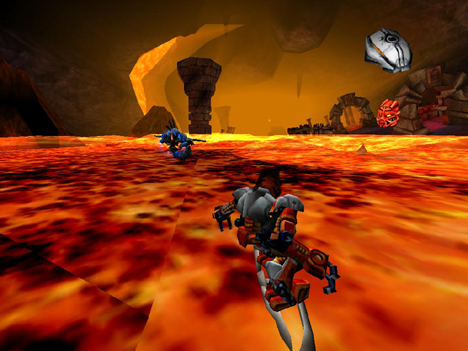
TAHU NUVA lava surfing.
This is a simple race. First to the KORO wins. If KURAHK wins, the KORO is destroyed (after a fade-to-black). If TAHU NUVA wins, KURAHK is tripped up and the Mask of Light goes skittering across the floor to TAKUA, who must know a short-cut to the KORO since he beat both TAHU NUVA and KURAHK there.
TAKUA puts on the mask, more by accident than intentionally, and becomes TAKANUVA. I am sorry if I spoiled the surprise for you, but if you did not know by now then it was time you do. What is more, the TOA-selection feature of the KINI NUI would certainly tip you off to this fact because they mis-spelled TAKANUVA as TAKUA NUVA.
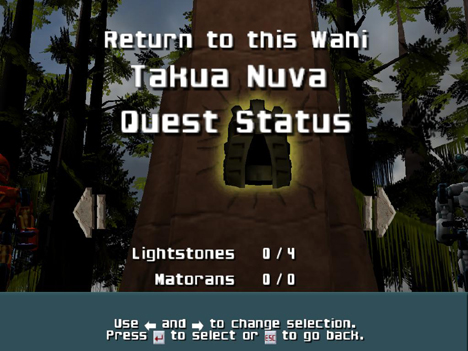
TAKUA NUVA?
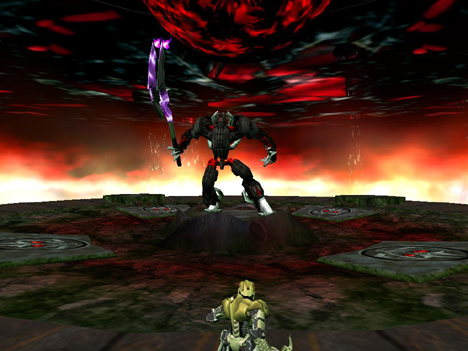
TAKUTANUVA vs MAKUTA
Anyone familiar with Mask of Light will recognize the ending to the game, but here it is far less cluttered and confusing than in the movie. It is somewhat disappointing in scope however, a frequent problem with adventure games.
The Camera
Your worst enemy in this game is not the RAHI, BOHROK, BOHROK-KAL, RAHKSHI, or even MAKUTA. No, your worst enemy is the camera. It is always moving at the most inopportune moments. If it is not moving, it is at the wrong angle. Sure, you can try to move it with the camera controls, but then more often than not it fights you the whole time and just snaps back to the wrong angle when you let go. This often makes the simple act of walking straight forward nearly impossible.
The camera also favors a perspective from way above your TOA/TOA NUVA. This severely limits your view of the scenery and, on several of the levels, can induce nausea.
The Controls
This was one of the most frustating parts of this game for me. In theory, you can play the game with any DirectX 9.0-compatible dual-analog game controller. The left control moves your TOA/TOA NUVA and the right controls the camera (somewhat, see above). Other controllers can also be used instead in conjunction with the keyboard if you set them up in the Options menu.
Everything seems to work using the game controller, but I discovered the most amazing thing. I can’t jump as far using the controller as I can using the keyboard. This is not some failing of mine. A simple forward jump just goes much farther if I use the keyboard instead of the controller. I tried two different controllers on my two different PCs with the same result.
I ran into a similar issue with KOPAKA. KOPAKA “skis” on his shield much faster on the keyboard than he does on the controller. Completing the KOPAKA level using the controller is exceptionally challenging. Completing the KOPAKA level using the keyboard is a piece of cake.
Given that there are several places where you absolutely have to jump as far as you possibly can or you can not proceed in the game, using a game controller is simply out of the question. Bite the bullet and use the keyboard exclusively. That really is too bad, because there are several places where the controller would be preferable if it actually worked.
Replay Value
The lightstones feature of the game does provide some replay value. When you return to a level you have previously completed, only those lightstones you did not collect previously are still available for collection. The ones you collected previously still count toward your total. Collect enough total lightstones and you unlock a “bonus”.
Just don’t expect much for your efforts. For example, the GALI NUVA level promises a sneak peek at new toys. Those toys are the RAHKSHI and the sneak peek is a commonly available movie of them.
Conclusion
Obviously, BIONICLE on PC CD-ROM has a great many problems. I believe at least some of those problems are because it was rushed to market so as not to suffer the same fate as its predecessor.
Beyond those problems, the something-for-everyone approach of the game dooms it to a certain level of mediocrity. But if you have a top-shelf gaming PC, stick to the keyboard, and ignore the story, then it does possibly offer some enjoyable gameplay in some interesting environments. My two young sons, who don’t have any other games like it, enjoy it immensely. In fact, they are bugging me right now to get off the computer so they can play.
0 Comments